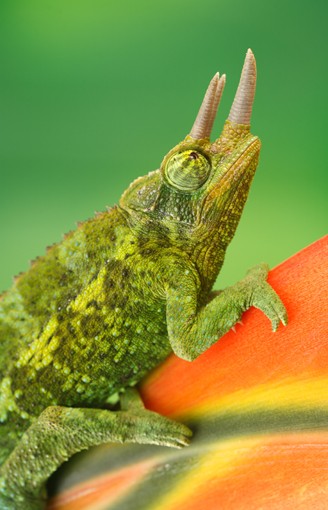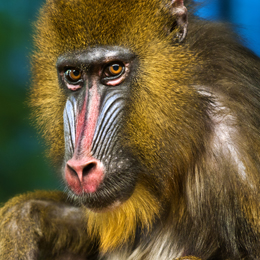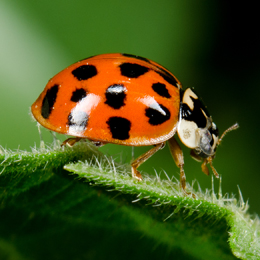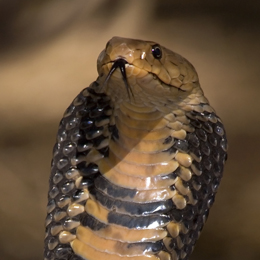Description
The Jackson’s Chameleon is named in honor of the famous English naturalist Sir Frederick John Jackson. He was one of the first naturalists who carried out extensive expeditions in Kenya. On his trips, he collected several specimens of native birds and reptiles species. Jackson’s three-horned chameleons originated in the land of the Kikuyu ethnic group in Kenya. Thus, it is also known as the Kikuyu three-horned chameleon.
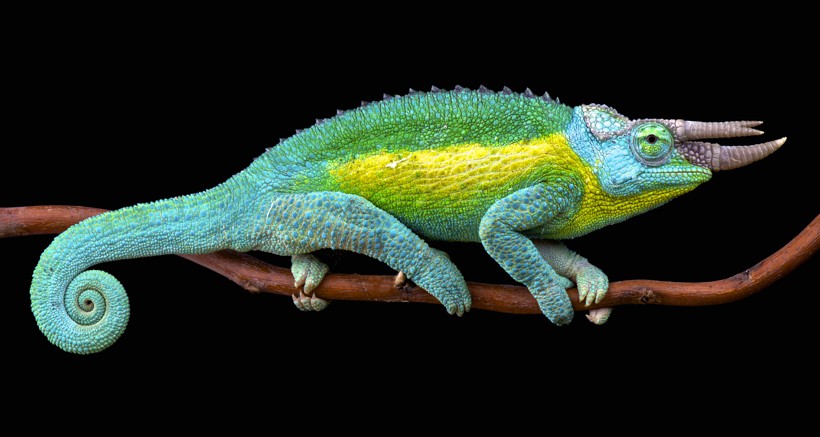
The Jackson’s chameleon’s tongue can be up to 2 times its body length!
?
Image credits: reptiles4all/Shutterstock
The Jackson’s Chameleons are easily recognizable as they have three horns on their snout. The rostral horn is the one on the nose while the two horns above each eye are called preocular horns. Female Jackson’s chameleons are smaller compared to males of the same age. An adult male can grow up to 38 cm (15 inches) in length while the adult female averages around 25 cm (10 inches) in length. The maximum age varies according to the conditions of its habitat. On average, a Jackson’s chameleon will live for up to 10 years. Healthy adults living in captivity can weigh up to 1 to 1.5 Kg, but the average weight of wild Jackson’s chameleons is lower due to lower availability of food sources in the wild.
The Jackson’s chameleon has a weak sense of smell and hearing. It can only hear tiny vibrations in the surroundings, which are often left by its potential prey animals. The chameleon primarily depends on its highly developed set of eyes. The chameleon's eyes can move independently, allowing a 360-degree vision for this reptile. The Jackson’s chameleon can, therefore, use one eye to spot prey while the other scans the surroundings for any potential threat. Unlike other creatures, the chameleon does not have split eyelids. Instead, the eye is protected by a single cone-shaped eye-lid. Once the prey is spotted, the chameleon’s binocular vision allows it to determine the exact distance of its prey.
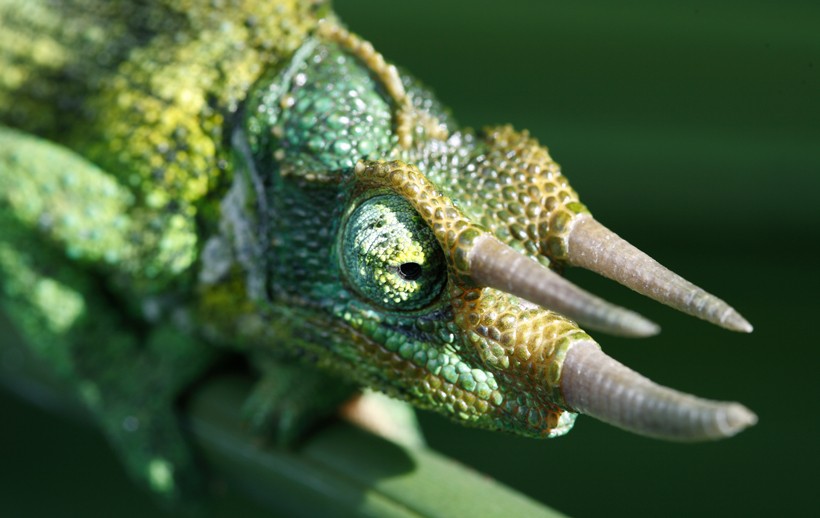
The chameleon’s binocular vision allows it to determine the exact distance of its prey.
?
Image credits: Shulevskyy Volodymyr/Shutterstock
Apart from visible light, chameleons can observe ultraviolet light in its surroundings. Like most reptiles, Jackson’s chameleon also uses its tongue as a sensory organ. It uses its tongue to detect chemical information from its surroundings and to transfer those signals to the Jacobson's organ located on the roof of its mouth.
Characteristics of Subspecies
There are three subspecies of the species Trioceros jacksonii.
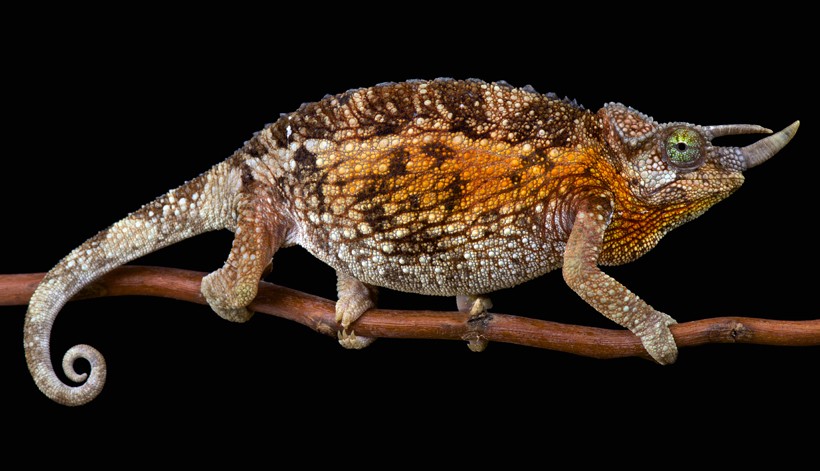
Trioceros jacksonii jacksonii
?
Image credits: reptiles4all/Shutterstock
- T. j. jacksonii
The T. j. jacksonii is the nominated subspecies, which is commonly known as the Jackson’s chameleon. It has the largest natural range of distribution compared to the other two subspecies. T. j. jacksonii grows up to 8 to 10 inches in size. Both males and females have three horns, but that of the females are smaller.
The T. j. jacksonii is the nominated subspecies, which is commonly known as the Jackson’s chameleon. It has the largest natural range of distribution compared to the other two subspecies. T. j. jacksonii grows up to 8 to 10 inches in size. Both males and females have three horns, but that of the females are smaller.
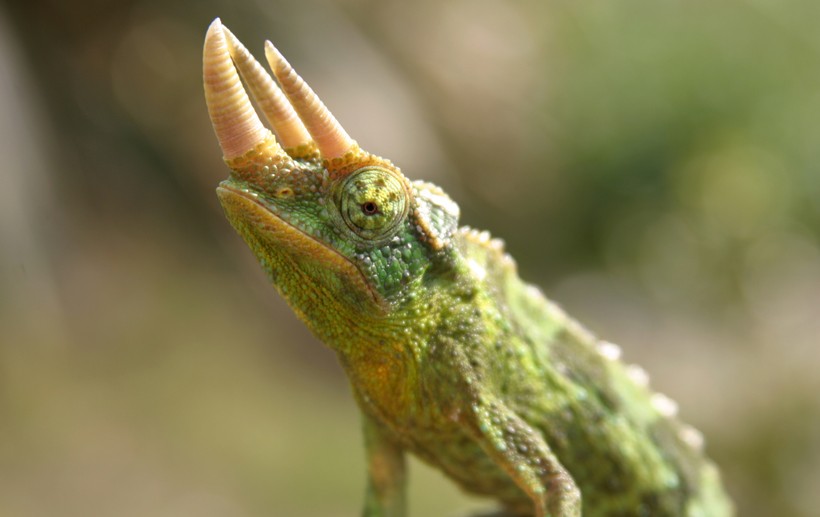
Trioceros jacksonii xantholophus
?
Image credits: mikeledray/Shutterstock
- T. j. xantholophus
T. j. xantholophus was discovered in 1988 in the Mount Kenya region. It is the most commonly occurring subspecies of T. jacksonii. Adult males of this subspecies are the largest as they grow up to 14 to 15 inches in length. Due its unique yellow crest, the species is also known as the Yellow-crested Jackson’s Chameleon.
T. j. xantholophus was discovered in 1988 in the Mount Kenya region. It is the most commonly occurring subspecies of T. jacksonii. Adult males of this subspecies are the largest as they grow up to 14 to 15 inches in length. Due its unique yellow crest, the species is also known as the Yellow-crested Jackson’s Chameleon.
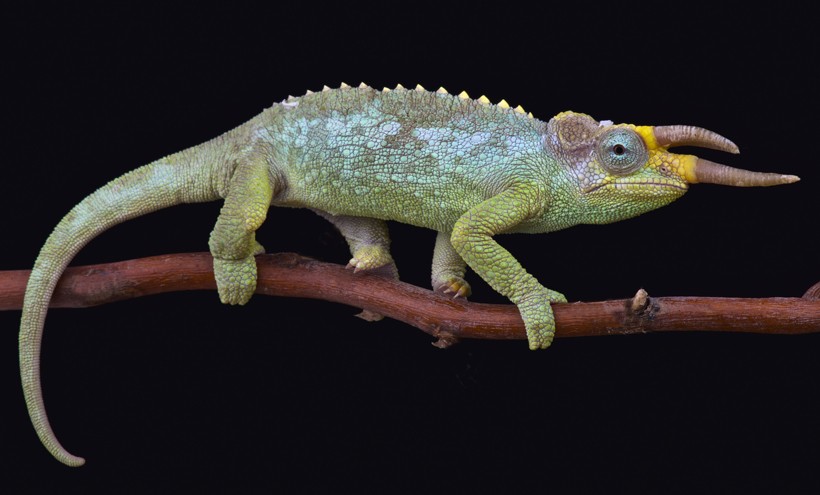
Trioceros jacksonii merumontanus
?
Image credits: reptiles4all/Shutterstock
- T. j. merumontanus
The smallest of all Jackson’s chameleon subspecies is the T. j. merumontanus. Adult males grow only a few inches in length; due to this, they are also known as the Dwarf Jackson’s chameleons. Dwarf Jackson’s chameleons are endemic to the Mt. Meru region of Tanzania. They can be distinguished by their small size, blue-green eyelids and the yellow color on its head. The body color is usually dark green, but a rare blue-green colored type of dwarf Jackson’s chameleons also exist in the wild.
The smallest of all Jackson’s chameleon subspecies is the T. j. merumontanus. Adult males grow only a few inches in length; due to this, they are also known as the Dwarf Jackson’s chameleons. Dwarf Jackson’s chameleons are endemic to the Mt. Meru region of Tanzania. They can be distinguished by their small size, blue-green eyelids and the yellow color on its head. The body color is usually dark green, but a rare blue-green colored type of dwarf Jackson’s chameleons also exist in the wild.
Habitat
Jackson’s chameleons occur in the woodlands of Kenya and Tanzania. Like all chameleons, the Jackson’s chameleon prefers an arboreal lifestyle. It spends most of the time on branches and trees of the woodlands at altitudes of 1600 to 2500 m. The forests at this height experience seasonal rainfalls and the daytime temperatures range from 15 to 30 degree Celsius. The Jackson’s chameleon is a cold-blooded creature, and thus depends on its surroundings to maintain its body temperature at appropriate levels.
A Jackson's chameleon starts its day by basking in the morning sun. Once the body is heated up, the chameleon becomes more active and starts searching for prey animals. Its color-changing skin provides a perfect camouflage in the forest while the chameleon searches for centipedes, snails, spider and other small insects. The chameleon uses its sharp vision to locate the prey and then slowly approaching it in a shaky motion to avoid being detected by the prey. Once the prey is in striking range, the chameleon uses its long tongue to grab the prey in a split second. A chameleon’s tongue can be up to 1/2 to 2 times the body length and the muscles in the chameleon's mouth allow it to shoot the tongue at great speeds. At the tip of its tongue, there is a cup-shaped flap of skin, which holds the prey firmly as it is dragged back to the chameleon’s mouth.
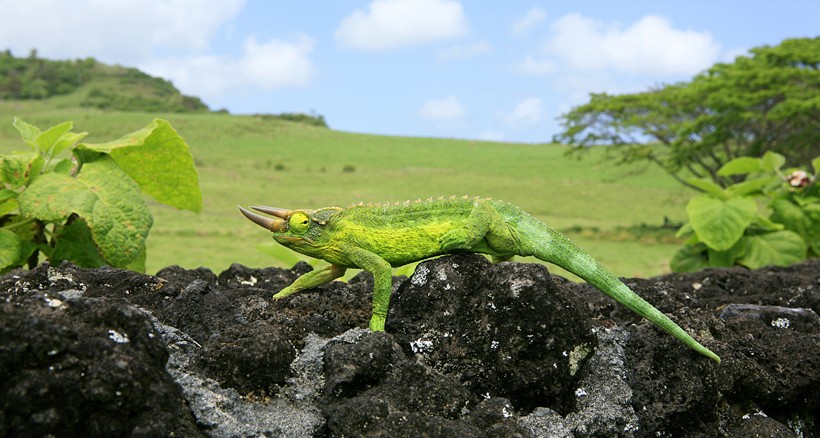
Jackson’s chameleons occur in the woodlands of Kenya and Tanzania.
?
Image credits: Robynrg/Shutterstock
In nature, the Jackson’s chameleon has a position at the bottom of the food chain. It has many natural predators like snakes, birds and monkeys. Their slow movement makes them highly vulnerable to predation. To avoid being spotted by predators and prey, the Jackson’s chameleon changes its skin color and blends itself into its surroundings. Moving as little as possible, it often allows the unsuspecting prey to move closer. However, once the predator spots a chameleon, the slow moving reptile is completely defenseless.
Reproduction and Lifecycle
Jackson’s chameleon reaches sexual maturity at an age of 5 months. The mating period depends on climatic conditions, as common with most cold-blooded creatures. Mating mostly occurs in the summer months, when the temperatures are higher and day time longer. During this period, the males perceive for females in its territory. Once a female is spotted, the male tries to impress her through a mating ritual display. The male flexes his neck muscles and uses head-bobbing while he slowly approaches the female. He will rapidly change the color of the skin in order to impress the female for mating.
When two males try to impress the same female, they compete with each other for mating rights. Each male tries to threaten the other by opening its mouth wide open and changing the skin to bright flashy colors. If this doesn’t work, the males go into a head-to-head fight. Both males lock their horns and try to push the other male off the branch. These fights are not dangerous; the weaker chameleon retreats quickly and the stronger one gets to mate with the female. Once the male gains access, he holds the female and mounts on her back. Copulation lasts for up to 15 minutes. The female continues mating with different males for the next 10 to 11 days.
Unlike most chameleons, the Jackson’s chameleon is viviparous and gives birth to live offspring. After a gestation period of up to 5 to 6 months, the female gives birth to 10 to 30 live babies, that are born in a semi-transparent embryonic sac. The female gives birth from a branch and let the offsprings fall onto the ground. The fall triggers the babies to emerge out from the membrane. Baby Jackson’s chameleons are completely independent and start hunting within a few hours from birth. After approximately 20 days the female is ready for mating again.
At birth, the newborn Jackson’s chameleon is only 5 to 6 cm in length. Though they are capable of hunting on their own, their small size makes them highly vulnerable to predation. Small birds, rodents and frogs can kill young Jackson’s chameleons for an easy meal. In 5 to 6 months the offspring attain sexual maturity and start looking for mates, repeating the reproduction cycle once again.
Behavior
The Jackson’s chameleon is a solitary reptile which prefers to live alone. Except during the mating season, Jackson’s chameleons avoid other chameleons regardless their sex. They are most active during the day. Most of the day is spent hunting and basking in the sun. The Jackson’s chameleon is not highly territorial in nature despite a sufficient availability of food sources.
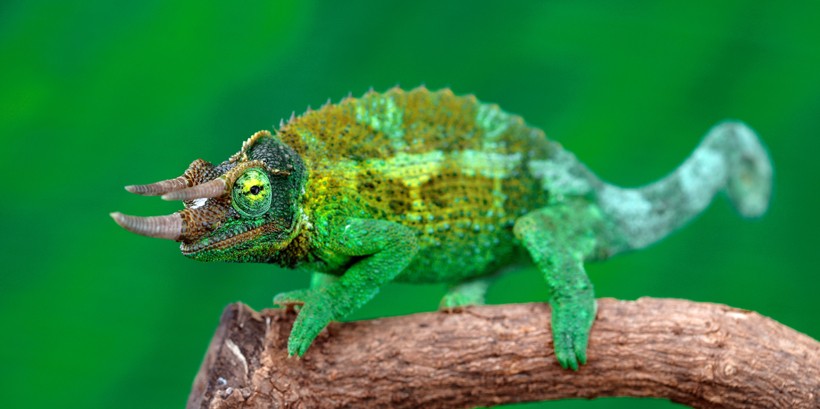
If a female is ready to mate with a male, she changes the color to bright green in order to express her acceptance.
?
Image credits: Shulevskyy Volodymyr/Shutterstock
Most of the communication is done through gestures. The bright flashy colors are used to warn any potential threat. Head-bobbing, opening the mouth wide open and flexing the neck are some of the most common gestures made by Jackson’s chameleons. If a female is ready to mate with a male, she changes the color to bright green in order to express her acceptance.
The precise hunting techniques and elaborate mating rituals indicate a moderate level of intelligence among Jackson’s chameleons.
Population and Conservation
Jackson’s chameleons are native to Kenya and Tanzania. Two of the three subspecies are spread widely throughout the forests of Kenya. The subspecies T. j. xantholophus was introduced to Hawaii in 1972 and since then, the species have spread rapidly across the region. Today, it is considered an invasive species in Hawaii. Despite their small range of distribution, the Jackson’s chameleons are flourishing in the wild. They reach sexual maturity at the age of just 5 to 6 months and with a lifespan of up to 10 years, a female gives birth to hundreds of chameleons. Often left undetected by predators, these slow reptiles have a good rate of survival as well. Due to all these factors, the IUCN list the species T. jacksonii, as “Least Concerned” in its red list of endangered species.
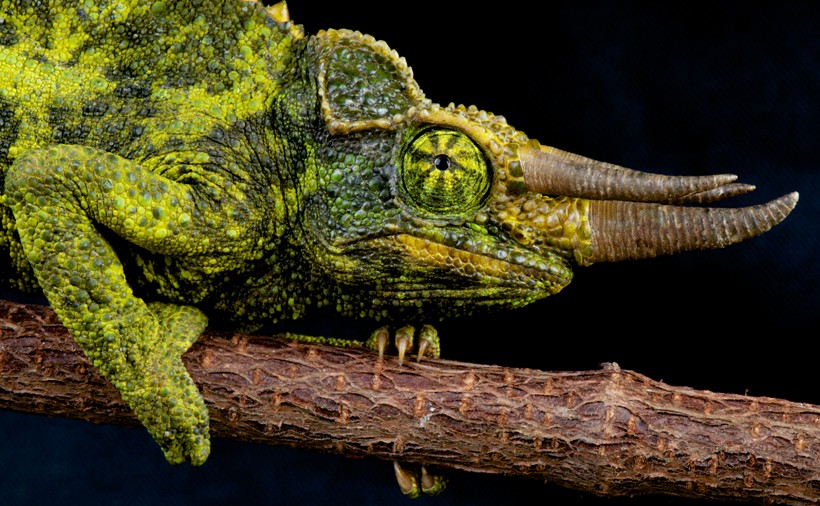
The IUCN list the species T. jacksonii, as “Least Concerned”.
?
Image credits: reptiles4all/Shutterstock
Evolution
It is believed that the chameleons shared a common ancestor with agamids and iguanids. The oldest known chameleon is the Anqingosaurus brevicephalus, which existed 50 to 60 million years ago in China. Fossils of chameleo intermedius of Upper Miocene period have been discovered in Kenya, indicating that several species of chameleons occurred in Africa and Eurasia. Researchers believe that chameleons must’ve originated in Africa and the species later migrated to Europe and Asia.
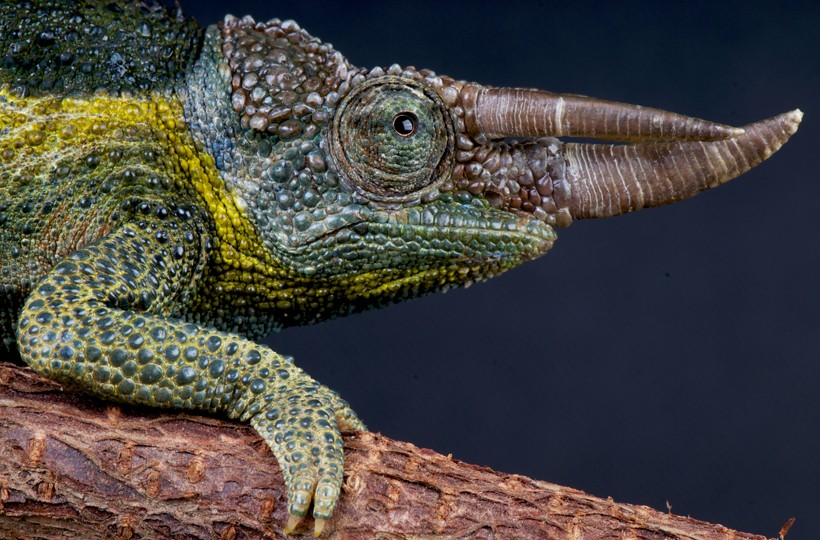
Researchers believe that chameleons must’ve originated in Africa
?
Image credits: reptiles4all/Shutterstock
Funfacts
- The Jackson’s Chameleon has three horns on its head, giving it the looks of a dinosaur named triceratops.
- The Dwarf Jackson’s Chameleon is found only in the Mt. Meru region of Tanzania.
- Jackson’s chameleons are viviparous, which means they give birth to live offspring.
- The subspecies T. j. xantholophus is the most widely spread Jackson’s chameleon. It is also raised as pets in captivity in many countries around the world.
- The nominated subspecies T. j. jacksonii has the widest range but it is quite rare throughout its range.
- An offspring Jackson’s chameleon is only 5 cm and few grams at birth.
- Jackson’s chameleons can live for up to 10 years.
- The T. J. xantholophus is the largest subspecies of Jackson’s chameleon. Adult males grow up to 15 inches in length.
- The Jackson’s chameleon’s tongue can be up to 2 times its body length.
